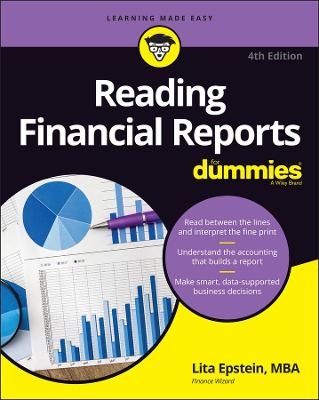
Reading Financial Reports For Dummies
For Dummies (Verlag)
978-1-119-87136-1 (ISBN)
In Reading Financial Reports For Dummies, you'll move step-by-step through each phase of interpreting and understanding the data in a financial report, learning the key accounting and business fundamentals as you go. The book includes clear explanations of basic and advanced topics in finance, from the difference between private and public companies to cash flow analysis.
In this book, you'll also find:
Full coverage of how to analyze annual reports, including their balance sheets, income statements, statements of cash flow, and consolidated statements
Real-world case studies and financial statement examples from companies like Mattel and Hasbro
Strategies for analyzing financial reports to reveal opportunities for operations optimization
Reading Financial Reports For Dummies is a can't-miss resource for early-career investors, traders, brokers, and business leaders looking to improve their financial literacy with a reliable, accurate, and easy-to-follow financial handbook.
Lita Epstein, MBA is a financial writer who focuses on career growth and business topics. She earned her MBA from Emory University and her BA from Rutgers University. Lita has written more than 40 books, including the previous editions of Reading Financial Reports For Dummies.
Introduction 1
About This Book 2
Conventions Used in This Book 2
What You’re Not to Read 2
Foolish Assumptions 3
Icons Used in This Book 3
Beyond the Book 4
Where to Go from Here 4
Part 1: Getting Started with Financial Reports 5
Chapter 1: Opening the Cornucopia of Reports 7
Figuring Out Financial Reporting 8
Preparing the reports 8
Seeing why financial reporting counts (and who’s counting) 9
Checking Out Types of Reporting 11
Keeping everyone informed 11
Following the rules: Government requirements 12
Going global 13
Staying within the walls of the company: Internal reporting 14
Dissecting the Annual Report to Shareholders 15
Breaking down the parts 15
Getting to the meat of the matter 16
Keeping the number crunchers in line 17
Chapter 2: Recognizing Business Types and Their Tax Rules 19
Flying Solo: Sole Proprietorships 20
Keeping taxes personal 20
Reviewing requirements for reporting 21
Joining Forces: Partnerships 21
Partnering up on taxes 22
Meeting reporting requirements 22
Seeking Protection with Limited Liability Companies 22
Taking stock of taxes 23
Reviewing reporting requirements 23
Shielding Your Assets: S and C Corporations 23
Paying taxes the corporate way 24
Getting familiar with reporting requirements 25
Chapter 3: Public or Private: How Company Structure Affects the Books 27
Investigating Private Companies 28
Checking out the benefits 29
Defining disadvantages 30
Figuring out reporting 31
Understanding Public Companies 32
Examining the perks 33
Looking at the negative side 34
Filing and More Filing: Government and Shareholder Reports 35
Quarterly reports 35
Yearly report 35
The rules of the Sarbanes-Oxley Act 36
Dodd-Frank’s impact on financial industry regulation 39
Entering a Whole New World: How a Company Goes from
Private to Public 41
Teaming up with an investment banker 41
Making a public offering 42
Chapter 4: Digging into Accounting Basics 45
Making Sense of Accounting Methods 45
Cash-basis accounting 46
Accrual accounting 46
Why method matters 46
Understanding Debits and Credits 48
Double-entry accounting 49
Profit and loss statements 50
The effect of debits and credits on sales 50
Depreciation and amortization 51
Checking Out the Chart of Accounts 52
Asset accounts 54
Liability accounts 56
Equity accounts 57
Revenue accounts 58
Expense accounts 59
Differentiating Profit Types 60
Gross profit 60
Operating profit 60
Net profit 61
Part 2: The Big Show: Annual Reports 63
Chapter 5: Exploring the Anatomy of an Annual Report 65
Everything but the Numbers 66
Debunking the letter to shareholders 66
Making sense of the corporate message 67
Meeting the people in charge 68
Finding basic shareholder information 68
Getting the skinny from management 68
Getting guarantees from management 72
Bringing the auditors’ answers to light 73
Presenting the Financial Picture 76
Summarizing the Financial Data 77
Finding the highlights 77
Reading the notes 78
Chapter 6: Balancing Assets against Liabilities and Equity 79
Understanding the Balance Equation 80
Introducing the Balance Sheet 80
Digging into dates 80
Nailing down the numbers 81
Figuring out format 82
Ogling Assets 84
Current assets 84
Long-term assets 88
Accumulated depreciation 90
Looking at Liabilities 91
Current liabilities 91
Long-term liabilities 92
Navigating the Equity Maze 93
Stock 93
Retained earnings 94
Capital 94
Drawing 94
Chapter 7: Using the Income Statement 95
Introducing the Income Statement 96
Digging into dates 97
Figuring out format 97
Delving into the Tricky Business of Revenues 100
Defining revenue 100
Adjusting sales 101
Considering cost of goods sold 103
Gauging gross profit 104
Acknowledging Expenses 105
Sorting Out the Profit and Loss Types 107
EBITDA 107
Nonoperating income or expense 108
Net profit or loss 109
Calculating Earnings per Share 109
Chapter 8: The Statement of Cash Flows 111
Digging into the Statement of Cash Flows 112
The parts 112
The formats 113
Checking Out Operating Activities 115
Depreciation 116
Inventory 116
Accounts receivable 116
Accounts payable 117
The cash flow from activities section, summed up 117
Investigating Investing Activities 118
Understanding Financing Activities 119
Issuing stock 119
Buying back stock 119
Paying dividends 120
Incurring new debt 120
Paying off debt 121
Recognizing the Special Line Items 121
Discontinued operations 121
Foreign currency exchange 122
Adding It All Up 122
Chapter 9: Scouring the Notes to the Financial Statements 123
Deciphering the Small Print 124
Accounting Policies Note: Laying out the Rules of the Road 125
Depreciation 126
Revenue 126
Expenses 127
Figuring out Financial Borrowings and Other Commitments 128
Long-term obligations 128
Short-term debt 129
Lease obligations 130
Mergers and Acquisitions: Finding Noteworthy Information 131
Pondering Pension and Retirement Benefits 132
Breaking Down Business Breakdowns 134
Reviewing Significant Events 135
Finding the Red Flags 137
Finding out about valuing assets and liabilities 138
Considering changes in accounting policies 138
Decoding obligations to retirees and future retirees 139
Chapter 10: Considering Consolidated Financial Statements 141
Getting a Grip on Consolidation 141
Looking at Methods of Buying Up Companies 147
Reading Consolidated Financial Statements 148
Looking to the Notes 150
Mergers and acquisitions 152
Goodwill 152
Liquidations or discontinued operations 152
Part 3: Analyzing the Numbers 155
Chapter 11: Testing the Profits and Market Value 157
The Price/Earnings Ratio 158
Figuring out earnings per share 158
Calculating the P/E ratio 159
Practicing the P/E ratio calculation 160
Using the P/E ratio to judge company market value (stock price) 162
Understanding variation among ratios 163
The Dividend Payout Ratio 164
Determining dividend payout 165
Digging into companies’ profits with dividends 165
Return on Sales 167
Figuring out ROS 167
Reaching the truth about profits with ROS 168
Return on Assets 168
Doing some dividing to get ROA 169
Ranking companies with the help of ROA 169
Return on Equity 169
Calculating ROE 170
Testing companies using ROE 170
The Big Three: Margins 171
Dissecting gross margin 171
Investigating operating margin 172
Catching the leftover money: Net profit margin 173
Chapter 12: Looking at Liquidity 175
Finding the Current Ratio 177
Calculating the current ratio 177
What do the numbers mean? 178
Determining the Quick Ratio 178
Calculating the quick ratio 178
What do the numbers mean? 179
Investigating the Interest Coverage Ratio 180
Calculating the interest coverage ratio 180
What do the numbers mean? 181
Comparing Debt to Shareholders’ Equity 182
Calculating debt to shareholders’ equity 182
What do the numbers mean? 183
Determining Debt-to-Capital Ratio 184
Calculating the debt-to-capital ratio 184
What do the numbers mean? 186
Chapter 13: Making Sure the Company Has Cash to Carry On 187
Measuring Income Success 188
Calculating free cash flow 188
Figuring out cash return on sales ratio 190
Checking Out Debt 191
Determining current cash debt coverage ratio 192
Computing cash debt coverage ratio 194
Calculating Cash Flow Coverage 196
Finding out the cash flow coverage ratio 196
Mattel 197
Hasbro 198
What do the numbers mean? 198
Part 4: How Companies Optimize Operations 199
Chapter 14: Turning Up Clues in Turnover and Assets 201
Exploring Inventory Valuation Methods 201
Applying Three Inventory Valuation Methods 204
Average costing 205
FIFO 206
LIFO 206
How to compare inventory methods and financial statements 207
Determining Inventory Turnover 208
Calculating inventory turnover 208
What do the numbers mean? 210
Investigating Fixed Assets Turnover 210
Calculating fixed assets turnover 210
What do the numbers mean? 211
Tracking Total Asset Turnover 211
Calculating total asset turnover 212
What do the numbers mean? 212
Chapter 15: Examining Cash Inflow and Outflow 213
Assessing Accounts Receivable Turnover 213
Calculating accounts receivable turnover 214
What do the numbers mean? 216
Taking a Close Look at Customer Accounts 217
Finding the Accounts Payable Ratio 218
Calculating the ratio 218
What do the numbers mean? 219
Determining the Number of Days in Accounts Payable 219
Calculating the ratio 220
What do the numbers mean? 220
Deciding Whether Discount Offers Make Good Financial Sense 221
Calculating the annual interest rate 221
What do the numbers mean? 222
Chapter 16: How Companies Keep the Cash Flowing 223
Slowing Bill Payments 223
Speeding Up Collecting Accounts Receivables 224
Borrowing on Receivables 226
Reducing Inventory 227
Getting Cash More Quickly 228
Part 5: The Many Ways Companies Answer to Others 231
Chapter 17: How Companies Find Errors: The Auditing Process 233
Inspecting Audits and Auditors 234
Looking for mistakes 234
Meeting Mr or Ms Auditor 234
Examining Records: The Role of the Auditor 235
Preliminary review 236
Fieldwork 236
Audit report 238
Filling the GAAP 238
Accounting standards: Four important qualities 239
Changing principles: More work for the FASB 240
Getting more involved internationally 241
Chapter 18: Government Regulations and Reporting Requirements 243
Checking Out the 10-Q 244
Financial information 244
Other critical matters 245
Introducing the 10-K 246
Business operations 246
Financial data 246
Information about directors and executives 247
The extras 248
Investigating Internal Controls 248
Uncovering the Ways Companies Keep in Compliance 250
Digging into Board Operations 252
Understanding the nominating process 253
Contacting board members 254
Finding Out about Insider Ownership 254
Chapter 19: Creating a Global Financial Reporting Standard 255
Why Develop a Worldwide Financial Standard? 256
Key Moves to Reshape Global Financial Reporting 256
Who Benefits from a Global Standard and How? 258
Investors 258
Capital Markets 258
Companies 258
Key Differences between GAAP and IFRS 259
Accounting framework 259
Financial statements 260
Revenue recognition 262
Assets 262
Inventory 262
Related-party transactions disclosures 263
Discontinued operations 263
Impairment charges 264
Chapter 20: Understanding the Analyst–Corporation Connection 265
Typecasting the Analysts 266
Buy-side analysts 266
Sell-side analysts 267
Independent analysts 270
Bond analysts 270
Regarding Bond-Rating Agencies 271
Delving into Stock Rating 273
Taking a Look at How Companies Talk to Analysts 274
Analyst calls 274
Press releases 275
Mobile apps 276
Road shows 276
Chapter 21: How Companies Communicate with Shareholders 277
Making the Most of Meetings 278
Checking Out How the Board Runs the Company 279
Watching the directors 279
Speaking out at meetings 281
Moving away from duking it out 282
Sorting through Reports 282
Catching Up on Corporate Actions 283
Culling Information from Analyst Calls 285
Listening between the lines 286
Knowing when to expect analyst calls 289
Staying Up-to-Date Using Company Websites 289
Regarding Reinvestment Plans 290
Dividend reinvestment plans 290
Direct stock purchase plans 290
Chapter 22: Keeping Score When Companies Play Games with Numbers 291
Getting to the Bottom of Creative Accounting 292
Defining the scope of the problem 292
Seeing through cooked books 293
Unearthing the Games Played with Earnings 295
Reading between the revenue lines 296
Detecting creative revenue accounting 300
Exploring Exploitations of Expenses 302
Advertising expenses 303
Research and development costs 303
Patents and licenses 304
Asset impairment 304
Restructuring charges 305
Finding Funny Business in Assets and Liabilities 306
Recognizing overstated assets 306
Looking for undervalued liabilities 309
Playing Detective with Cash Flow 311
Discontinued operations 311
Income taxes paid 312
Part 6: The Part of Tens 315
Chapter 23: Ten Financial Scandals That Rocked the World 317
Enron 318
Madoff 319
Citigroup 319
Adelphia 320
WorldCom/MCI 320
Tyco 321
Waste Management 322
Bristol-Myers Squibb 323
Halliburton 324
Arthur Andersen 325
Chapter 24: Ten Signs That a Company’s in Trouble 327
Lower Liquidity 327
Low Cash Flow 328
Disappearing Profit Margins 328
Revenue Game Playing 329
Too Much Debt 330
Unrealistic Values for Assets and Liabilities 330
A Change in Accounting Methods 330
Questionable Mergers and Acquisitions 331
Slow Inventory Turnover 332
Slow-Paying Customers 332
Glossary 333
Index 341
| Erscheinungsdatum | 31.03.2022 |
|---|---|
| Sprache | englisch |
| Maße | 185 x 234 mm |
| Gewicht | 499 g |
| Themenwelt | Mathematik / Informatik ► Mathematik |
| Wirtschaft ► Betriebswirtschaft / Management ► Rechnungswesen / Bilanzen | |
| ISBN-10 | 1-119-87136-0 / 1119871360 |
| ISBN-13 | 978-1-119-87136-1 / 9781119871361 |
| Zustand | Neuware |
| Informationen gemäß Produktsicherheitsverordnung (GPSR) | |
| Haben Sie eine Frage zum Produkt? |
aus dem Bereich


